In the future, problems may arise due to insufficient knowledge and skills and insufficient availability of people and resources.
It is important to make the content and knowledge available as e-learning or micro-learning. Possibly with practical sessions. The e-learning can also be supplemented with a Virtual Reality application, 2 or 3 dimensional animations, interactive videos, gamification solutions or a combination of these.
Based on proven solutions, content is also supplemented with own innovations and integrations. In this blog we will tell you how far we are in this and what is still needed.
Is innovation expensive? No, just cost effective!
By making adequate and relevant knowledge available at all times, costs can be reduced. By making broad and deeper knowledge available exactly when it is needed, people and resources can be deployed more flexibly. Very interesting for many organizations.
Are these only hopes for the future?
No, because a large part of this innovation has already been realized, such as the methodology to make existing content available via Artificial Intelligence (AI) and partly offer it as micro learning to the right people, when they need it.
It is then possible to make the learning results available to management via dashboards and to store them in a special database (Learning Record Store). This can be done as Experience API statements.
A practical example with semantic data: “John has performed an exercise well”. This data can be linked to Learning Journeys, so that it can be analyzed what the level of knowledge transfer is and which employees need which specific support for additional knowledge and skills.
The advantage of this is that it transcends traditional e-learning! Practicing a separate simulation or performing a real-world assignment can be tracked in this way and used for follow-up actions and analyses.
What is needed to realize this?
A component that is being further developed within the ILIAS community (ILIAS is the basic platform that is also used by the Dutch Defense), is the possibility to have the system automatically determine who still needs to learn what via AI.
This is to make him or her deployable for working with specific resources. This will realize further cost savings. With regard to the learning contents, it is possible to work with, for example, VR technology or the linking of a simulator.
The development is therefore still mainly in the area of advice/remediation with the aid of Artificial Intelligence.
However, this knowledge and expertise is available within existing projects and/or under development. The Future Learning consultants can join in to put the right expertise into practice. The rest of the standardized infrastructure is available based on the ILIAS learning and knowledge transfer platform.
Innovation in learning is therefore within reach!
The importance of Dynamic Quality for the Creation of Happiness
About: the Value of Quality in Life
The concept of dynamic quality cannot be defined. It can only be understood intellectually through the use of analogy. This is why the Dynamic beauty of a piece of music can be recognized before a static analysis explaining why the music is beautiful can be constructed. Dynamic quality can be poetically described as the force of change in the universe; however when an aspect of Quality becomes repeated, it becomes static.
Robert Pirsig, the writer of the famous bestseller “Zen and the Art of Motorcycle Maintenance” defines ‘static quality’ patterns as everything which can be defined. Everything found in a dictionary, for instance, is a static quality pattern. Pirsig then divides static quality into inorganic, biological, social, and intellectual patterns, in ascending order of morality (based on evolutionary order). These static forms, if they have enough ‘high’ or ‘low’ quality, are given names and are interchanged with other “sentient beings”, building the base of knowledge for a culture.

To give an example of this. Look at your favourite shop, why do you go there and not to another one? Is it because the quality of the products they sell or is there something else that is important but almost indefinable. I think the dynamic quality is about the joy you perceive in a particular shop, in addition to the actual product that you buy. Having a more or less personal relationship with the owners is more important.
How does happiness relate to this? Very simply, it is about the small things that have to do with Emotional and Social Intelligence. Are you invited to have an espresso or cappucino just to taste the quality of the machine or it more about sharing a moment?
Robert Pirsig wrote another book called “Lila: an Inquiry into Morals“. This semi-autobiographical story takes place as the author sails his boat down the Hudson River, even meeting Robert Redford, Phaedrus, the author’s alter ego is jarred out of his solitary routine by an encounter with Lila, a straightforward but troubled woman who is nearing a mental breakdown.

The most important thing to learn here is that creating happiness is all about small things. And they are quite easy to create every day. Just by recognizing what is beautiful and simple to achieve.
Recommendation: focus on quality with everything you do, also small things, and reflect upon it regularly.
Emotional intelligence and the 30% rule: less is more
About: Focus only on the essential and the best
Steve Jobs already said it, after returning to Apple from Next, while being involved in Disney. Focus on the incredibly good ideas and leave the rest. He himself was an example of an abundance of creativity and focus on “beautiful things”. But maybe sometimes a little bit too much to be successful with them. Examples are the Lisa Computer, the original Macintosh and the Next computer.
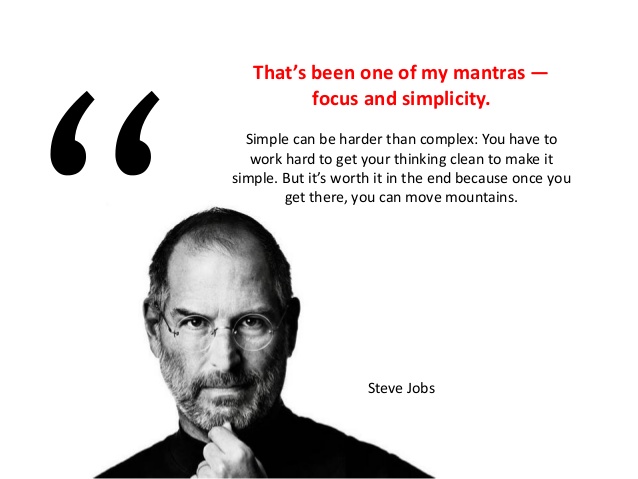
But he was finally able to learn from his mistakes. This is were emotional intelligence comes to play an important role. He really learned from being fired from Apple after he made mistakes, and he also learned from the mistake he made with the Next project. But after returning to Apple, he did not make these mistakes anymore and discarded any not really excellent product on the roadmap.
Also, by correcting an another mistake made before during Apple times. Changing the focus on hardware to a focus on software. He brought in the software he created for Next as the next software platform for Apple products in general. To keep and make things simpler. Another example here is to change from the Motorola chip sets not to the IBM chip sets but to the Intel chip sets and finally to ARM chip sets. So, the focus on software allowed for flexibility on the hardware side.
The same is true for Elon Musk with all of his companies and products, simplicity and flexibility. He can change the rockets being built from carbon fiber to stainless steel foreseeing problems and difficulties while the concept stays the same. A rocket powered by methane and oxygen, because methane can be harvested on Mars. But what is really important in his concept is the focus on software not on hardware. The Tesla cars will get a completely new software soon for Self Driving, which he himself is already using and testing. This is because basically Elon Musk is a software guy, his first product was a game he created himself. And a focus on simplicity. If you look at all the ideas that led to companies than you can clearly see this.
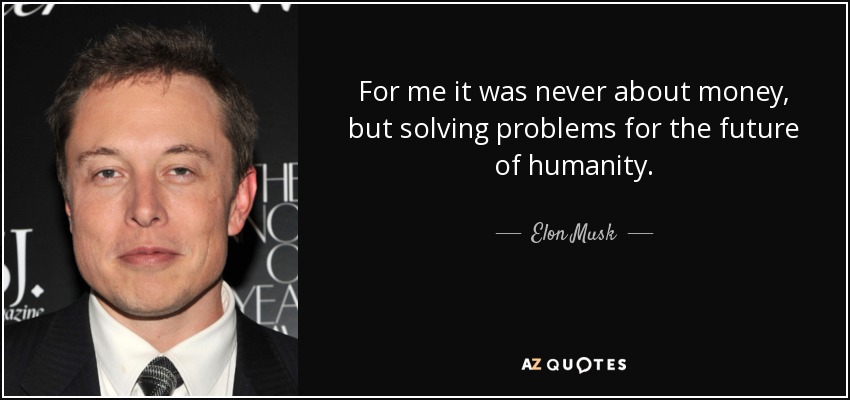
Interestingly because both Apple and Tesla are known for their innovative and beautiful hardware. A Tesla is a driving computer or actually it is a driving big smartphone. The hardware can be adjusted to the needs of human beings. Made more beautiful or more comfortable, more usable. The focus on the human being is on the hardware side. This is what makes Apple and Tesla stand out. The focus on emotional intelligence, things that appeal to human beings and not only to nerds.
Another example that immedately comes to mind is Mozart. Maybe even the best example. He could create very complex music, as Bach did with his fugues. But his most well known pieces are simple such as his father Leopold created (the Children Symphonie). Think of Eine Kleine Nachtmusik composed right after his father died. But also Rondo Alla Turca and the melody for the Dutch national hymn Wilhelmus. And above all the Magic Flute which reached other audiences than just the elite. His Requiem is a magic and wonderful combination of complexity and simplicity which he wrote for himself when he felt his end coming near (Agnus Dei). Mozart had a very productive life next to being creative and having a lot of ideas all the time. He was able to create a vast repertoire by focusing on the really beautiful ones mostly driven by important things that happened in his life such as love and death.
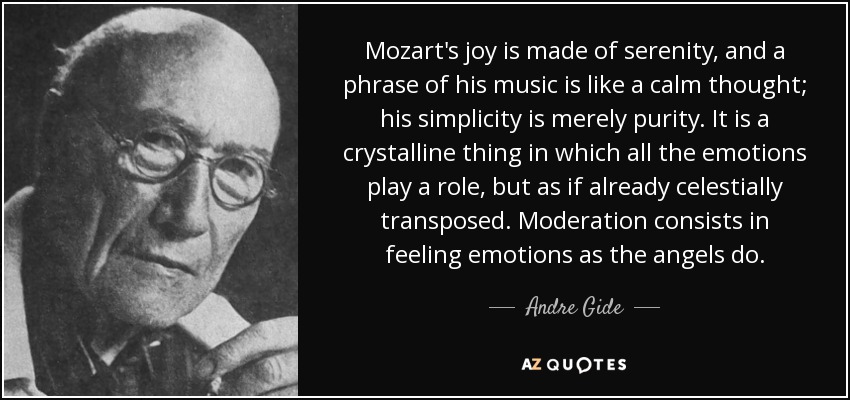
It is not only about focus here, but to apply emotional intelligence into your everyday life. Jobs, Musk and Mozart are very good examples. Apart from all of their technological brilliance (Zu schön für unsere Ohren und gewaltig viel Noten, lieber Mozart). Just enough he replied). They were and are able to translate their talents into really useful products and solutions for the benefit of other human beings and humanity in general. This is the real genius and what can be called the 30 percent rule.
Why do you need the 30 percent rule? We live in an age of distraction. Never-ending notifications, instantaneous communication, and easy access to endless information. Fear of missing out moves us motivates us to try to do everything that our minds and hearts desire. But as we quickly move from one thing to another, preferably using our mobile phones (actually we have become computers more or less) we discover that we can’t do everything. If we try, we will not do anything well.
Jobs knew this. Elon Musk know this and acts upon this because he wants to achieve a goal. Mozart learned to do this from a very early age being asked by his father to perform for royalty. It could not only be a gimmick but hat to be really appealing music. The total becomes more than the sum of its parts. By focusing on the 30 percent, the best of the best, we can create a simpler and a better life that is really enjoyable and productive. How to make the 30 percent rule work for you? Find things that are fun and interesting to work on. But don’t forget that everything takes time and resources which are limited.

So, you have to ask yourself if you make the best use of your resources. Are you focusing on the best of the best you can do? Am I wasting time on useless things? What is the most important is to take time to analyze and reflect objectively. Do this every day or every week. Learn from your mistakes. They are not really mistakes but learning points. Make changes if needed, correct the mistakes or don’t take them anymore. If you think things through, choose wisely, and work hard–you can do it right and create the most beautiful, complex complex and simple things. As Einstein used to say: Everything should be made as simple as possible, but no simpler. Use your emotional and social intelligence. We are already smart enough anyway.
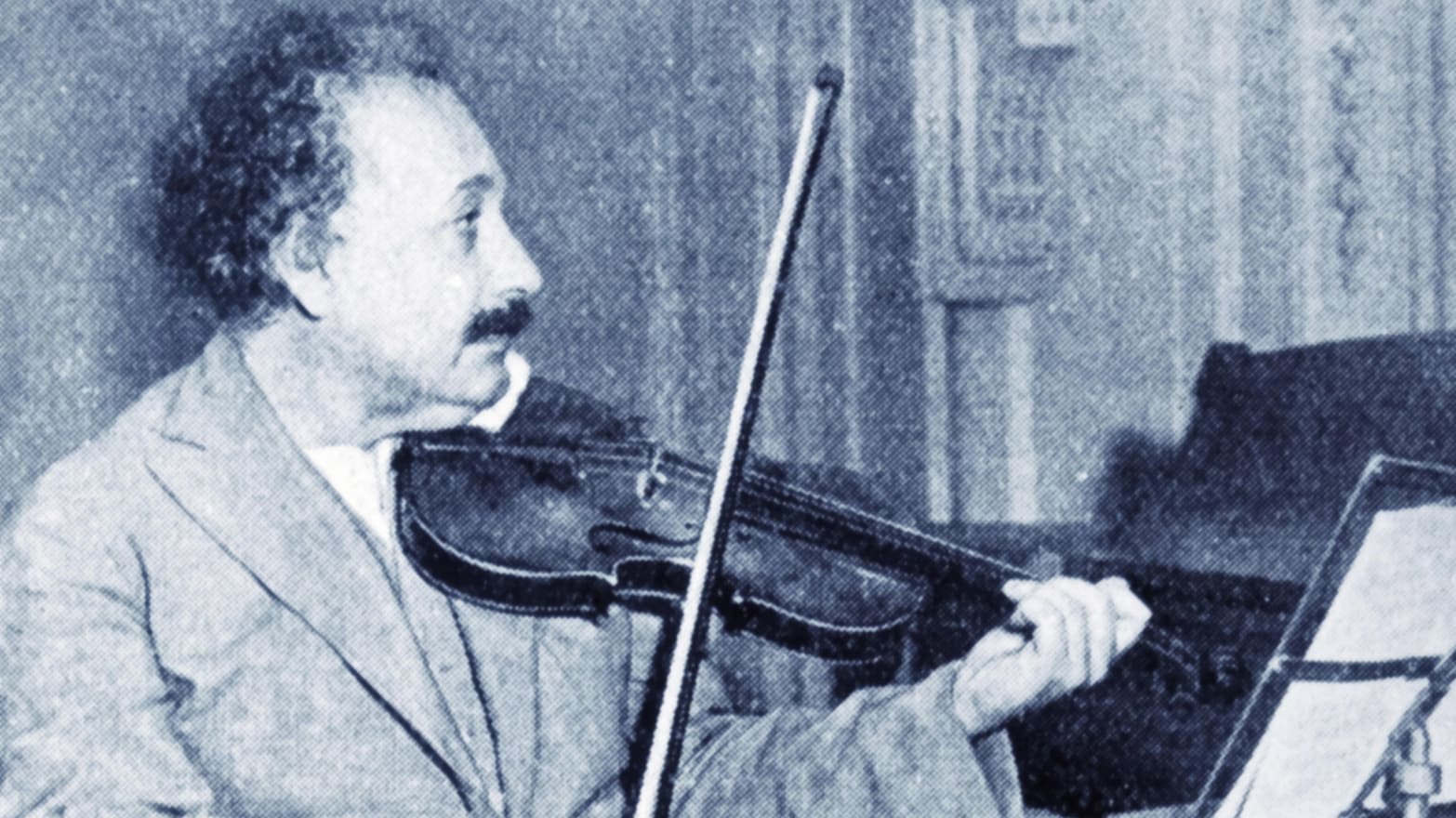
Recommendation: Make a list of things that you want to achieve, follow it the next days. Look at what you already have achieved and what is not important. Add more and better goals.
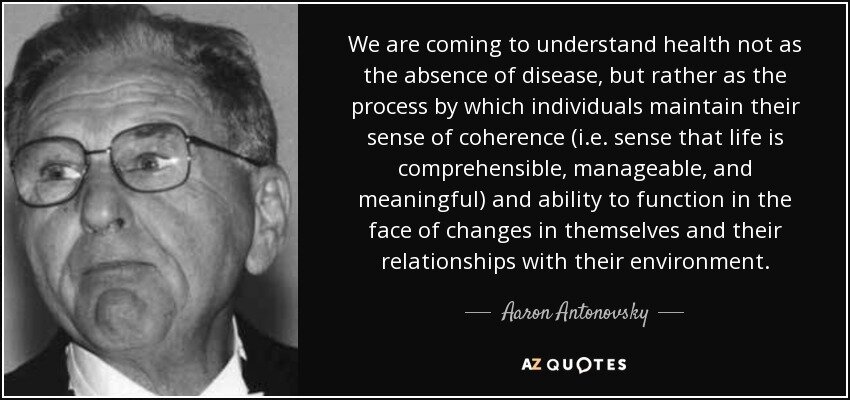
Salutogenesis: How to Be Happy and Healthy
About: Focus on health and well-being
Salutogenesis is the opposite of pathogenesis which means looking for issues, problems that need to be solved in order to become healthy and happy. Salutogenesis means to look for the positive things even when things are not optimal. Salutogenesis is concerned with the relationship between health, stress, and coping. It provides an umbrella, paraplu or parasol of many different resources that protect against unhappiness and in general to help being healthy.
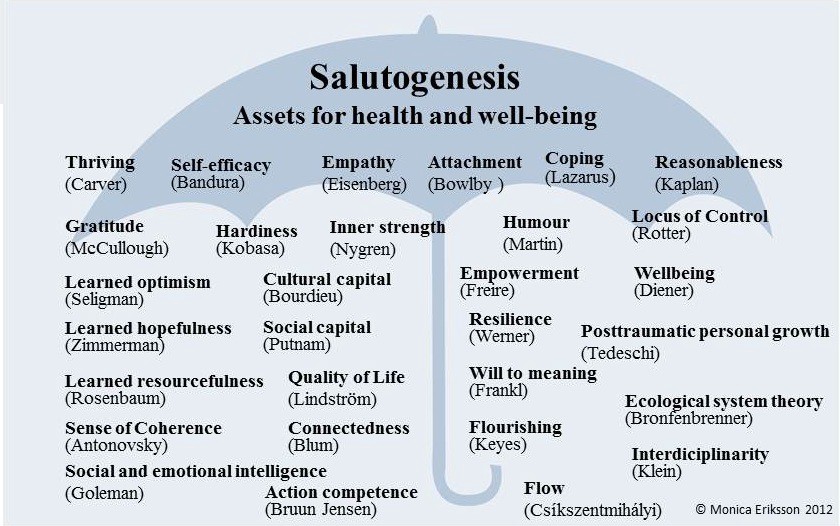
Many people have the approach to look for eternal happiness by eradicating the negative things in life. We call this a focus on pathogenesis. To look for perfection in e.g. your house, your job, your relationship. Or just drinking 100 or 50 euro bottles of wine, that taste exactly the same as the 10 to 5 euro bottles of wine. People will find out that when these goals have been reached there are new goals of perfection have to be achieved. So maybe the problem is not to achieve perfection or happiness, but to continuously look for perfection and happiness,.
But why not focus on the good things already there? Even in difficult times as we experience right now. That is a different approach and can be reached fairly easily. By just doing it. It takes less time and effort and it leaves less room for continuous improvement. Focus on things like gratitude, self-efficacy, hardiness, empathy and humor (the umbrella).

In this view, happiness does not happen in the future. But it is there already and now. And to take action to make it happen in the River of Life. It was inspired by what wild salmons do. They are born in a river and then swim all the way to the Ocean where they feed and grow. Then they swim back to the river where they were born and even are able to jump up to high levels because they became very strong.
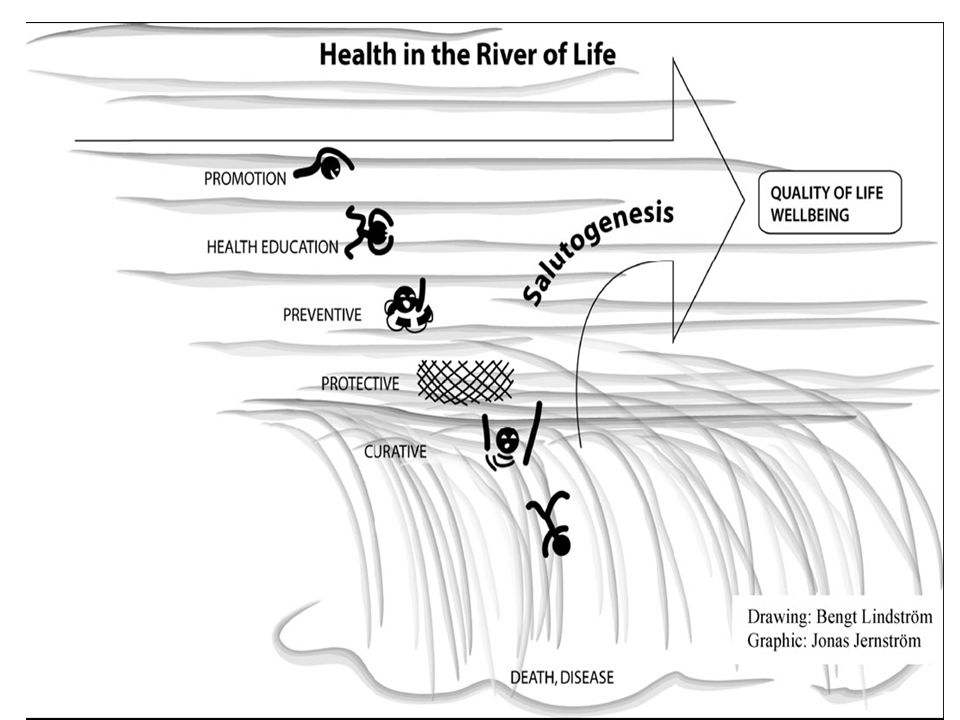
Achieving happiness is actually quite simple. Just use your strength and do the things that make you happy with the people that make you happy and with the person that you are and that you are with. Don’t wait for happiness. A list of things you can do today:
- Being there, as in the story about the gardener who became the president (book by Jerzy Kosinski and movie with Peter Sellers)
- Connecting with people. Develop your social and emotional intelligence.
- Do what you love to do, whatever it is. Cook, walk, visit, listen, see, talk.
- What are the good things everyday? They can be unexpected and paradoxical.
- Only do work that you like to do. Are you good at text editing, translation, technology and you like to do it. Just do it and lose yourself in your work. It gives you a sense of meaningfulness especially if you can share this with others.
- Help other people, it is not very difficult.
- Reflect everyday, end of day before you go to sleep. Take it with you to bed.
- Pay attention to small things. Such as reading, talking, walking, breathing, listening to the birds or the wind in the trees.
- Taking care of other people, whoever they are. It is simple and easy.
- Express gratitude. Also an easy thing to do once you start paying attention to small things.
- Become a lifelong learner. Read more.
- Simplify your life by eliminating unnecessary things and creating chaos. The minimal lifestyle.
- Make a small change, fix or repair in your house. Get it from the list.
- Slow down. Not everything can or will happen quickly. You can take a day off sometimes.
- Exercise every day and develop your own little program. Walking in nature is an easy thing to do, as are simple yoga exercises.
- Accept that things not always go the way you want them to go. The world is less than perfect.
- Be aware of wonderful things in life. This can be something someone else is doing, such as launching a rocket to the Moon or Mars. Or it can be a great book, recipe, wonderful music or knowledge or person.
- Go to the water to swim, sail, walk or just take a boat. Listen to the sounds of the water, the wind and look at the sky, the sun, the blue water and the blue sky.

Don’t do all of these things at the same time. Just pick and choose what makes most sense to you. And above all it is not necessary to achieve perfection. Actually this will make you unhappy, which is the paradoxical truth. A great book to read about this topic is: The Situation Is Hopeless, But Not Serious: The Pursuit of Unhappiness by Paul Watzlawick. A blog post will follow soon about his psychology.
Recommendation: It is easy to focus on negative things, such as anxiety or a high pulse rate and seek for immediate relief or attention. But it is better to have a mid-term or long-term view on the positive things such as feeling well and to have healthy, positive thoughts.
Developing Talent with Balance
About: The balance between skill, motivation and personality
The word talent comes from the Greek word Talenton, which means scales or balance. Later, this word has come to take on a different meaning, in general aptitude, giftedness. It stands for what someone has in their luggage to be able to successfully execute a certain job and grow within the organization. But that original meaning is interesting. It is not just about the ability itself but about the balance between the three components: being able, wanting and being. In other words, competencies, motivation and personality. If this balance is and remains in order, then talent can be dynamic and a person can grow into a position and the talent can continue to develop.

It is a prerequisite in today’s economy. Society and technology are developing at a very rapid pace. Every year there are new developments in the fields of energy, sustainability, communication and information technology, biotechnology and artificial intelligence. Companies and organizations need people who can function well and contribute in these innovative and challenging times.
More and more social and emotional intelligence are important, and a little bit less about the basic competencies because they are constantly changing. The ability to work well together and communicate with others and learn from others on the basis of their own personal characteristics in order to be able to share knowledge and (re)use knowledge. Personal characteristics such as resilience and curiosity and being able to listen and work together well are now the most important abilities. To be able to balance your talents.
The balance between competence, motivation and personality is very important. Every individual person has a lot of knowledge and deepening and broadening of knowledge takes place on the basis of individual needs. When you start out in a job you have different knowledge needs than an experienced operator. But both positions must be able to grow in their talent within their careers and personal life.

What is very important is that knowledge is shared. So that a talent pool is created with the right knowledge to start provided by more experienced people. Also to be able to develop new talents. It may be that the knowledge of very experienced people is not sufficiently available in education. Experienced people make their knowledge available with the aim of developing the future-proof talent needed for today’s society and business. And they can focus on new areas. Think about people like Wernher von Braun who made available his knowledge and experience from to enable Moon rockets last century and Mars rockets this century. The Saturnus 5 rocket from the 1960’s is still not equaled, but will be very soon. It was actually designed as a Mars rocket. He also predicted the name of Elon as the leader on Mars in a book on Project Mars. Another multi-talent. People with multiple talents have to balance them much in the same way as a professional juggler. But only accompanied by a balanced lifestyle.
Recommendation: Develop your talents all the time, but do not focus only on skills, but also what you want to achieve and what it means to you.
Become Calm With Subtle Audiovisual Stimulation
About: Communication which is 90% non-verbal
ArkDes (Architecture and Design) Museum in Stockholm lies next to the Modern Museet at Skeppsholm. Here one can visit an exhibition about ASMR called Weird Sensation Feels Good. ASMR stands for Autonomous Sensory Meridian Response. Basically it is about subtle audiovisual stimulation. It is a tingly sensation that usually begins in the crown of the head and works its way down the back and through the limbs. The feeling is extremely relaxing and is often triggered by soft sounds, soft voices, whispering and light touching. Many people have an ASMR experience during a head massage or a facial, having their hair played with or while someone strokes their arm.
Most individuals who experience ASMR, have strong memories of when this feeling was triggered as a child. For me, I always remember enjoying eye tests, having my hair played with and quiet time in class as the other students read books and slowly turned the pages. It is also triggered or combined with visuals as can be seen on the videos on the ArkDes Website.

ASMR is a term that describes a physical sensation: euphoria or deep calm, sometimes a tingling in the body. In recent years an online audience of millions has grown, dedicated to watching the work of designers and content creators who try to trigger this feeling in their viewers.
Here is an example of calming sounds. It can be sounds, but also a voice. E.g. think about the voice of the hairdresser while cutting your hair. How does ASMR relate to calmness? Well, ASMR videos Youtube and the Calm App both offer accessible relief from day-to-day stress.
Not everyone experiences the sensation of ASMR. Even for those who experience it, the videos made to induce it are not always appealing. Each person has a unique set of triggers, in the same way, that people prefer different food or music. That’s why there is a huge variety of content available. Some people who have never heard of ASMR videos or who have different sensitivities find it hard to understand the intention behind them or why others might enjoy them. Millions of people experience this calming effect. It’s a lot of fun and wonderful to see people enjoying this calmness together, but it is also being able to reach out to others with love, kindness, acceptance, and courage is everything. Sensitive people of the world can unite with ASMR. We can make a difference! It just works.
Recommendation: It is very important to daily reflect or meditate. Amient non-verbal sounds and visual can be used to almost hypnotize the brain for this purpose.
Learning Analytics Creëren
Het nut en doel van leerstatistieken en analyses (aka Learning Analytics) met H5P
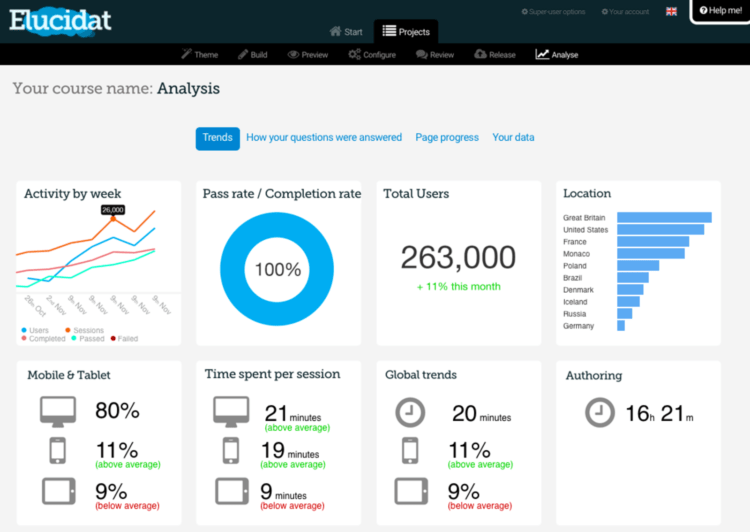
In de moderne samenleving evolueert leren zich zeer snel. Kennisdeling en kennisoverdracht worden steeds noodzakelijker “on the job” en “du moment”. Leren wordt hierdoor ook steeds socialer, minder formeel en zeer mobiel. Meer van elkaar leren dan van de “sage on the stage”. Leerervaringen zijn allang niet meer beperkt tot een klaslokaal, maar vinden vaak zelfs volledig online plaats. Dit kunnen we zien aan de snelle opkomst van video gebaseerd leren, bijvoorbeeld op basis van 360 graden video. Steeds meer zijn leervaringen visueel, interactief en immersief om de realiteit dicht te benaderen dan met tekst, afbeeldingen en vragen, waardoor de effectiviteit en de efficiëntie van het leerresultaat toeneemt. Zodat uiteindelijk het verschil tussen realiteit en leren zal vervagen ook ondersteunt door kunstmatige intelligentie. Learning by doing on the job, ondersteund door echte of kunstmatige coaches en mentoren en alle benodigde informatie. Leer en werkomgeving zullen uiteindelijk volledig worden geïntegreerd in een hybride omgeving van kunstmatige en menselijke intelligentie. Dit wordt ook wel blended of modern leren genoemd.
Het waarom van xAPI in H5P
Deze toenemende diversiteit en complexiteit van leerervaringen creëert grote uitdagingen voor de leveranciers en gebruikers van leeroplossingen. Hoe kunnen studenten op de hoogte worden gehouden van hun “blended” leerproces, en hoe wordt kennisoverdracht vastgelegd binnen “blended” leren? Hoe volgen we behaalde leerdoelen, en hoe worden alle essentiële gegevens over leerresultaten vastgelegd, geanalyseerd en gerapporteerd in een willekeurige benodigde vorm? De leertechnologie is zeer snel is geëvolueerd in de afgelopen 20 jaar, en daarom zijn ook de normen en standaarden voor leertechnologie continu bijgesteld, vooral op het gebied van het volgen en opslaan van data. Er werden in 2007 al verschillende whitepapers geschreven op uitnodiging van LETSI (Learning-Education-Training Systems Interoperability) om na te denken over de toekomst van de leertechnologie en wat er nodig is voor de nabije toekomst. Deze input op basis van zowel leertechnologie leveranciers en gebruikers heeft geleid tot het idee van het centraal stellen van de leerervaringen voor echte mensen en deze zo weinig mogelijk in te perken wat betreft het volgen ervan. Of het nu het lezen van een boek is, het bekijken van een video tot een simulator van een Joint Strike Fighter. Er werd een nieuwe standaard of API (Application Programming Interface, d.w.z. een methode om verschillende systemen te koppelen) bedacht op basis van al deze input. Daarom heet deze standaard dan ook Experience API of xAPI, met als bijnaam Tin Can. Je weel wel door middel van een touwtje en twee blikjes naar elkaar luisteren. Het gaat om deze interface om alle mogelijke leerervaringen op een gestandaardiseerde wijze te koppelen en de data te op te slaan en te gebruiken zonder al te veel restricties en open naar de toekomst. Deze xAPI is in 2014 gepubliceerd en wordt eigenlijk pas nu in 2019 echt in gebruik genomen.
Wat kan er worden gedaan met xAPI in leren met H5P?
xAPI is ontworpen voor alle denkbaar mogelijke leerervaringen, inclusief traditioneel klassikaal leren en het meest geavanceerde online of offline leren, waarbij de resultaten met elkaar vergeleken kunnen worden. Het centrale idee achter xAPI is dat alle mogelijke leeractiviteiten zoals bijvoorbeeld video, mobiel, sociaal, offline, traditioneel kunnen worden vastgelegd om er op individueel niveau op te kunnen rapporteren, of om de gegevens te aggregeren op elk gewenst niveau om beter te begrijpen hoe leren werkt in de hele organisatie en deze resultaten te kunnen combineren met andere system en correleren met bijvoorbeeld bedrijfsresultaten.
Het ontstaan van xAPI in H5P
In 2016 deed ik zelf mijn eerste xAPI-project voor een klant in de VS om een eerder gecreëerde SCORM-architectuur (SCORM is de voorgaande standaard uit te vervangen die een aantal ernstige nadelen had, vooral in termen van het verzamelen van accurate gegevens voor analyse. Dit project was gebaseerd op een combinatie van xAPI en H5P voor het maken en leveren van e-learning inhoud, voornamelijk video-based. Het belangrijkste voordeel is dat veel nauwkeurige gegevens nu worden verzameld voor onmiddellijke aggregatie en voor verdere analyse en zakelijk gebruik zoals bijvoorbeeld voor het individueel ondersteunen van studenten, predictive analyse en adaptief leren. Het is veel gemakkelijker om data te delen tussen verschillene systemen en verschillende content providers om inzichten te creëren die voorheen niet mogelijk waren of heel veel tijd vergden. Bijvoorbeeld het combineren van leerresultaten met customer relatie management gegevens of HR systemen. Voor dit project werd xAPI voor het eerst geïntegreerd in het H5P authoring en content management systeem. Bijvoorbeeld bij het bekijken van interactieve video, het maken van vragen en het bekijken van presentaties. Daarna bleek snel dat er veel vraag was naar xAPI in H5P en heeft xAPI in H5P zich snel geevolueerd. Bijvoorbeeld in het onderwijs wordt het gebruikt als een soort opname recorder waardoor leerervaringen kunnen worden afgespeeld en geanalyseerd voor mentoring en coaching. xAPI is net als H5P een relatief nieuwe standaard, ook open source en daarom past het goed bij elkaar. Er is een goede reden waarom H5P ontwikkeld is als alternatief voor Flash en xAPI als alternatief voor SCORM. H5P heeft SCORM dan ook nooit ondersteund. Maar wel LTI en xAPI. Hierdoor kunnen systemen door middel van API’s gekoppeld worden en is er geen monolytisch LMS meer nodig. Natuurlijk kan H5P op deze manier ook met een LMS gekoppeld dat LTI ondersteund wordt en ook met een LRS (Learning Record Store) zodat de leerresultaten vanuit het LMS (zoals Moodle, ILIAS, Canvas, Brightspace) op basis van H5P leerervaringen terugvloeien naar een LMS en daar met behulp van dashboard kunnen worden bekeken en er kan zelfs geaggreerde data terug worden gestuurd naar een LMS zonder dat iemand daar iets van merkt. Het is volledig transparant. Daarnaast heeft de H5P.com server variant ook een eigen rapportage systeem op basis van de xAPI data, waardoor het niet altijd nodig is een LRS te implementeren.
xAPI verschilt aanzienlijk van eerdere standaarden zoals SCORM en AICC. In tegenstelling tot SCORM en AICC is xAPI niet beperkt tot eLearning-materiaal of Learning Management Systemen (LMS). Er worden Statements gegenereerd die worden opgeslagen in een Learning Record Store.
Het uiteindelijke doel van xAPI in H5P
Het doel van de xAPI is het opslaan en bieden van toegang tot alle mogelijke leerervaringen, zowel digitale als echte wereld. Zowel mobiel als offline. De xAPI maakt het bijhouden van leerervaringen mogelijk met statements, inclusief traditionele records zoals scores of voltooiing. Het slaat ook records op van de acties van studenten, zoals het lezen van een artikel of het bekijken van een trainingsvideo en hoe ze ermee omgaan. Dit kan zover gaan als het opslaan van alle toetsaanslagen of muisklikken indien nodig. Eigenlijk elke actie die belangrijk is voor het volgen van het leerproces kan worden opgeslagen. xAPI maakt het ook mogelijk om activiteiten te volgen die mensen doen met behulp van computers zoals het uitvoeren van werktaken, het produceren van werkresultaten, interactie met anderen met behulp van sociale media, het behalen van mijlpalen in games en simulaties, en zowat elke andere activiteit die men kan observeren of opnemen.
Hoe het werkt in H5P
De xAPI beschrijft leeractiviteiten als een stroom van semantische data. Elke instructie bestaat uit een actor, een actie en een object. I (actor) deed (actie/werkwoord) iets (object)
Een paar voorbeelden:
- James Las een artikel uit de Harvard Business Review genaamd “the employer-LED Health Care Revolution”
- Mary beantwoordde een testvraag.
Mensen leert van interacties met andere mensen, content en taken. Deze leeractiviteiten kunnen in principe overal gebeuren en referenen aan een evenement waar leren kan optreden. Al deze activiteiten en gebeurtenissen kunnen worden opgenomen met de xAPI. Wanneer een activiteit moet worden geregistreerd, verzendt de toepassing beveiligde instructies in de vorm van “Ik heb dit gedaan” of “zelfstandig naamwoord, werkwoord, object” naar een Learning Record Store (LRS). De LRS registreert alle gemaakte verklaringen en kan deze verklaringen delen met andere LRSs of met een compatibel LMS, met inbegrip van SCORM en AICC gebaseerde systemen. De LRS kan ook ‘ slimmer ‘ werken door statistiek toe te passen, en de ontstane aggregatiegegevens kunnen worden gebruikt voor verdere analyse bieden. bijvoorbeeld geavanceerde Multilevel statistische modellering en correlatieanalyse of machine learning technieken kunnen worden toegepast om voorspellingen over Real-World prestaties met betrekking tot trainingsgegevens te automatiseren. In H5P hoeft niets speciaals te worden gedaan. Alle activiteiten in alle H5P content types worden automatisch en vrijwel meteen dynamisch verstuurd naar het LRS als xAPI data. Sommige content types sturen meer gegevens dan andere, maar dit wordt voortdurend door de H5P community bijgesteld. In principe is alles mogelijk ook muisklikken, pauzeren in video’s, toetsaanslagen (dit wordt al gebruikt bij de Surveys wanneer mensen een open vraag invullen).
De voordelen van xAPI in H5P
Alle leerervaringen in een H5P interactieve Video Contenttype worden bijgehouden: van het starten van een video, het stoppen, beantwoorden van een vraag, het gebruik van ingesloten inhoud zoals een PDF, het beantwoorden van een vraag, het zoeken naar een videofragment, het afronden van een afsluitende toets tot de totale weergaveduur wordt bijgehouden met behulp van de Experience API en kan worden gebruikt voor analyse en rapportage. Maar dat hoef je niet allemaal te gebruiken. Er kan worden gefilterd en geaggregeerd. Er is ook geen vaste volgorde nodig van leeractiviteiten. Mensen kunnen hun eigen pad kiezen dat maakt voor H5P en xAPI niet uit.
Door al deze data van H5P leeractiviteiten te combineren met bedrijfs, personeels of klantgegevens, kunnen er worden begonnen met het identificeren van leertrajecten die leiden tot de meest succesvolle resultaten, kan de effectiviteit van trainingsprogramma’s worden bepaald en de zogenaamde return on investment worden gemeten. Dit kunnen meetbare KPI’S in de gezondheidszorg, effectiviteit van onderwijscontent, verkoopprestaties, talent of performance management of het verbeteren van leerervaringen zijn. In het voorbeeld hieronder wordt de voortgang uitgezet tegen de betrokkenheid van een van de belangrijkste voorspellers van leer effectiviteit en efficiënt van leren.
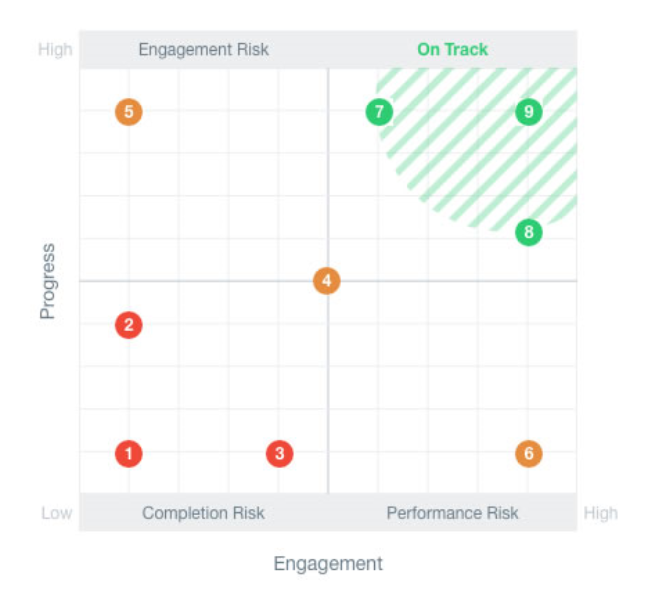
Met xAPI zijn dit soort analyses gemakkelijker te maken door data van verschillende bronnen te combineren. Daar is xAPi voor gemaakt. Dus in H5P kan er met het ingebouwde rapportage systeem worden gewerkt voor leerervaringen die vanuit een LMS of portal worden gestart via LTI, en tegelijkertijd worden de data doorgestuurd naar een LRS, geaggregeerd, doorgestuurd naar een LMS en doorgestuurd naar een HR systeem.
Bij het project dat ik deed voor een Corporate University in de VS werden alle xAPI-gegevens verzameld via H5P leeractiviteiten om op deze manier voorgang verbonden aan motivatie te voorspellen. Dit stelt hen in staat om de juiste interventies te geven aan individuele studenten, value for money te geven, maar ook voor het het plannen van up en cross selling activiteiten en zelfs voor marketing en uiteindeljk heeft dit bijdragen tot verbeterde bedrijfsresultaten door meer transparantie en inzicht. Dit allemaal door de combinatie van H5P met xAPI
Waarom past H5P zo goed bij xAPI en bij het Moderne Leren in het algemeen?
- H5P en xAPI zijn open en flexibel
- H5P en xAPI zijn toekomst gericht
- H5P en xAPI worden wereldwijd steeds meer gebruikt
- H5P en xAPI zijn dynamisch in plaats van statisch
- H5P en xAPI zijn robuust en uitbreidbaar
- H5P en xAPI ondersteunen het moderne leren op basis van de modernste technologieën
- Leerresultaten en content zijn volledig uitwisselbaar
- H5P en xAPI maken het mogelijk om leerresultaten volkomen uitwisselbaar en analyseerbaar te maken
Deze combinatie pas zeer goed bij de vereisten van het Moderne Leren: flexibel, toekomstgericht, interactief, immersief, internationaal, dynamisch, robuust, mobiel, uitwisselbaar, gericht op big data, gericht op learning analytics, predictive analytics, gepersonaliseerd leren. Dit gaat niet vanzelf natuurlijk, er moet wel wat voor worden gedaan. Maar in elk geval is het mogelijk. Het zijn eigenlijk grote bouwdozen met LEGO voor Leren waar in principe alles mee kan wat nodig is voor het Leren
Neem contact met ons op voor het creëren van Learning Analytics met H5P in uw eigen leeromgeving.
Göran Kattenberg (goran@theblendedgroup.nl)

Meetup Interactieve Video voor Blended Leren

Op 13 maart 2019 was er een Meetup over Interactieve Video, georganiseerd door de Losmakers. Een interactieve video is een video waarbij de kijker in actie moet komen. Hij k,an kiezen hoe hij verder gaat of vragen beantwoorden. Er waren zo’n 25 tot 30 mensen van verschillende organisaties aanwezig, met name geïnteresseerd in de toepassing van interactieve video bij online leren. Het gebruiken van interactieve video voor leren bestaat al lang. Denk hierbij aan Philips CD-i en de interactieve beeldplaat. Het Amerikaanse leger gebruikte het al tijdens de Tweede Wereldoorlog. Door de goede video kwaliteit en de mogelijke interactiviteit werden in de negentiger jaren al trainingsprogramma’s en opleidingen gemaakt en gebruikt bv. bij de uitrol van nieuwe automodellen, maar ook voor het trainen van personeel bij afvalzuiveringsinstallaties. Met name binnen het beroepsonderwijs of na en bijscholing voor het beroepsonderwijs werd interactieve video uitermate geschikt bevonden, in combinatie met meer tekstuele leermaterialen.
Met de opkomst van het internet werd in eerste instantie de kwaliteit van video een stuk lager door de beperkte bandbreedte en nam de toepassing van video in eerste instantie af. Dat probleem bestaat nu nauwelijks meer en daarom is de interesse voor het gebruik van interactieve video voor training, opleiding en leren weer toegenomen. Mede ook door de opkomst van nieuwe technologieën zoals 3D, 180 en 360 video en de relatief goedkope apparatuur om video’s te maken en uit te leveren via toegankelijke platforms.
De laatste paar jaar zijn daar tools bijgekomen om interactieve video’s online te maken en uit te leveren. Dit komt vooral door de opkomst van online video platforms zoals Youtube en Vimeo. Deze platforms bevatten ook al tools om video’s meer interactief te maken, zoals het maken van bladwijzers.

Isabelle Langeveld (onderwijskundige en onderwijstechnologe) hield een inleiding over het gebruik van multimedia bij leren. De tekeningen in deze blog zijn van haar hand. Isabelle’s stelling is dat mits op de juiste wijze toegepast, d.w.z. rekening houdend met leerpsychologische en onderwijskundige principes (bv. de First Principles of Learning van David Merrill) de combinatie van video of in het algemeen multimediaal materiaal met tekst, vragen en hotspots in een specifieke volgorde een positief effect heeft op het leereffect en de retentie over langere tijd en daarnaast neemt de cognitieve belasting (d.w.z. het intensieve gebruik van het korte termijn geheugen) af.
Uit wetenschappelijk onderzoek (e.g. Nassi & Callaway, 2009) blijkt dat visuele en ruimtelijke informatie verwerking parallel verloopt terwijl auditieve en tekstuele informatie verwerking via het korte termijn geheugen sequentieel verloopt. Doordat video de juiste context al aanbiedt kan de cognitieve belasting worden verminderd en wordt als het ware de essentiële te leren informatie op de juiste wijze, plaats en manier verwerkt en opgeslagen. Oftewel, een meer breinvriendelijke manier van leren. Door tekstuele en auditieve sequentiële informatie in de juiste audiovisuele context te plaatsen. Dat is wat ook in de werkelijkheid gebeurd, het is een meer immersieve, ondergedompelde manier van leren in dit geval mogelijk gemaakt en ondersteund door technologie.
Een voorbeeld van interactieve video gemaakt in H5P
Een terechte opmerking vanuit het publiek was of muziek of audio ook zinvol kan zijn of juist contra productief. Hierbij kan natuurlijk onderscheid worden gemaakt tussen spraak (voice-over), ambient geluid (achtergrond geluiden) en muziek (achtergrond muziek). Het antwoord is dat het kan helpen mits het breinvriendelijk wordt toegepast, d.w.z. mits het niet leidt tot een overload van het werkgeheugen maar gebruikt wordt om tekstuele informatie en visuele informatie met elkaar te verbinden door meer context aan te brengen en ook door de tekst te verduidelijken (voor lezen van tekst). Dit geldt in bijzondere mate voor zogenaamde toegankelijke content, wanneer studenten bijvoorbeeld een visuele handicap hebben of juist andersom een auditieve handicap. In dat laatste geval kan het ook zinvol zijn om met ondertitels te werken naast spraak.
Elke aanwezige leverancier kreeg de kans om zijn product kort te presenteren en toe te lichten. Mijn toelichting als innovatie consultant met onder andere enkele grote projecten met interactieve video en learning analytics, ging over H5P (HTML5 Package). H5P is een volledige webbased omgeving voor het maken van immersieve e-learning content. Komt uit Noorwegen en bestaat al een jaar of 6. Het is gemaakt om zeer laagdrempelig te zijn, dus iedereen kan het effectief gebruiken, zowel docenten als studenten. De bedoeling is dat vele gebruikers kennis en informatie gaan delen en gebruiken. Er zijn vele mogelijkheden om e-learning content te maken. Niet alleen interactieve video, maar er zijn ook vele andere mogelijkheden. Interactieve video is één van de content typen die gebruikt kunnen worden om content te aggrereren, d.w.z. er kan een bestaande vraag worden toegevoegd aan een video of bestaande tekst, graphics en ook video. Het wordt in Nederland inmiddels toegepast bij Radboud Universiteit binnen een pilot voor een jaar gekoppeld aan hun Brightspace LMS. De bedoeling is dat zowel docenten als studenten kennis en vaardigheden gaan bijdragen en delen. Er zijn ook twee nieuwe content typen, branching scenario en virtual tour die op een andere manier kunnen worden toegepast om content te aggregeren. De vier andere tools in deze evaluatie zijn specifieke tools voor het maken van alleen interactieve video. Daarnaast hebben de andere vier tools in de evaluatie een commercieel model, terwijl H5P een open source project is. Er is wel een professionele SAAS variant met SLA en verwerkersovereenkomst die voldoet aan de strengste eisen, die door grotere organisaties wordt gebruikt zoals universiteiten, bedrijven en NGO’s. De hosting vindt in dat geval plaats door de maker van H5P, Joubel, via Amazon servers. Hierbij wordt voor grotere aantallen gebruikers de prestatie van video bijvoorbeeld gegarandeerd.
Er vonden twee groepsgewijze evaluatie sessies plaats. Hierbij werd gekeken naar de interacties die kunnen worden gemaakt binnen videos, hoe gebruikersvriendelijk de tools zijn. En wat is nu eigenlijk de didactische meerwaarde, in vergelijking met een ‘gewone’ video waar je interacties voor, naast of onder aanbiedt? Een en ander werd beoordeeld binnen het onderstaande model (kwaliteitsweb)

Hierbij wordt meteen duidelijk dat H5P gemaakt is voor gebruikersvriendelijkheid zowel voor makers (docenten, studenten, professionals) als voor de eindgebruikers (studenten, medewerkers, stakeholders). De kosten van H5P zijn laag, zowel voor de gratis versie, waarvoor alleen een WordPress of Drupal server nodig is als voor de professionele versie waarbij men betaalt voor de hosting voor een specifiek aantal gebruikers gekoppeld aan het LMS en met ingebouwde analyse tools en rapportages. Wat betreft de functionaliteit is H5P zeer uitgebreid op het gebied van interactieve video. Er kunnen hotspots en een 9 tal vraagtypen of enquetes worden toegevoegd. Hierbij kan er adaptief worden vertakt, op basis van het antwoord op een vraag springt men naar een bepaalde positie in de video. Hetzelfde geldt voor hotspots. Het eindresultaat wordt aangeboden in een gebruikersvriendelijke speler met navigatie en branching die binnen elke website of LMS naadloos kan worden geïntegreerd.
Wat nog interessant is om te vermelden dat H5P ook content typen biedt waarbij interactieve video kan worden geaggregeerd of gecombineerd. Bijvoorbeeld een vertakking waarbij men van de ene video naar de andere springt in een adaptief leerpad dat met xAPI statements kan worden gevolgd met Learning Analytics. Tenslotte is het nog interessant om te vermelden dat H5P ook meegaat met de huidige trend om met 360 graden content type kunnen werken, Augmented Learning. De zogenaamde Virtual Tour ondersteunt 360 foto’s, waarbij makkelijk paden kunnen worden gemaakt om bijvoorbeeld in een gebouw rond te kunnen lopen (zoals een werkplaats, garage of fabriek) om realistische scenario’s te kunnen maken. De volgende stap hierin zal ook 360 video zijn die met een VR bril zoals de Oculus Go of Google Cardboard bril kan worden bekeken. De immersie gaat hier nog een stap verder.
De volgende Meetup zal dan ook over het onderwerp Virtual Reality gaan. Interactieve video opgenomen en afgespeeld in 360 graden is hierbij de eerste stap. Overigens kan deze content ook prima op bestaande laptops, tablets en smartphones worden gebruikt.

Toepassingsmogelijkheden liggen op het gebied van sales training, onboarding, standaard procedures, werkinstructies, product trainingen, technische trainingen, waarbij de nadruk ligt op het dichterbij brengen van de realiteit bij het onderwijs. H5P is hierbij de sleutel tot succes. Een aantal bezoekers van de meetup hebben zich al gemeld om te kijken hoe zij H5P kunnen gebruiken om sneller, gemakkelijker, beter en leuker kennis te gaan delen en uitwisselen met en voor hun doelgroep.
Een belangrijk aspect is dat interactieve videos gemakkelijk gemaakt kunnen worden in een online omgeving en ook gemakkelijk kunnen worden gebruikt in een willekeurige leeromgeving (bv. via LTI). Daarnaast dat er veel relevante data wordt geproduceerd in interactieve video’s, veel meer dan bv. in reguliere e-learning content. En dat het mogelijk moet zijn om naast de standaard leervoortgang zoals voltooiing, score en geslaag/niet geslaagd het ook mogelijk moet zijn om alle gebruikersdata te gebruiken en op geslaan om onmiddellijk te analyseren of nader hand te gebruiken voor bijvoorbeeld het personaliseren van bestaande en nieuwe leerpaden. Dit kan op basis van de Experience API die semantische data produceert zoals Vera heeft op deze Knop Gedrukt (actor – verb – object gegevens met context). Bijvoorbeeld dat was om een vraag te beantwoorden in een quiz of dat was in een simulatie van een kerncentrale. Oftewel, interactieve video’s kunnen ook heel goed gebruikt worden voor het genereren van data voor Learning Analytics.
Online Education Introductie
De onderstaande video laat zien hoe een klant van The Blended Group een presentatie geeft voor eigen personeel over het nieuwe digitale onderwijs kanaal dat is gecreëerd voor 50.000 internationale studenten van een groot trainingsinstituut (Online Academy). Voorwaarde was dat alles wat klassikaal beschikbaar was ook digitaal en online beschikbaar werd en tegelijkertijd meetbaar en analyseerbaar zowel voor de studenten zelf als voor docenten/coaches en mentoren en dat de effectiviteit van leerprocessen kan worden vergeleken met real-world performance. Binnen een paar maanden werden al miljoenen views geregistreerd en Experience data vastgelegd voor Learning Analytics via de xAPI standaard in een LRS. H5P wordt gebruikt voor het zelf maken van interactieve video content met ingebouwde toetsen en daarnaast ook losse toetsen in gepersonaliseerde leerpaden en leertrajecten. Later nog meer over die interessante project dat in een half jaar is gerealiseerd en dat meteen al resultaten opleverde door middel van innovatieve leertoepassingen op basis van gedegen vooronderzoek zowel didactisch als technisch en door nauwe samenwerking tussen het team aan de klantzijde en ons.
Er wordt gewerkt met zowel lecture captures (interactief) als eigen video producties (talking heads van de beste docenten of door acteurs). Daarnaast met opnames van simulatie sessies van software toepassingen die in de praktijk worden gebruikt. Er wordt ook gewerkt met zogenaamde branching scenario’s, adaptieve leerpaden op basis van interactie.

How Experience API Supports Business Outcomes
Learning is evolving. It is becoming more social, less formal, and highly mobile. Learning is no longer restricted to a classroom, as we can see from the quick rise of video-based learning.
There are big questions looming for current learning providers: how can we keep learners engaged and properly manage learning and skill transfer? How do we properly track learning success and capture data about their learning outcomes? As the technology has evolved, so too have the learning standards. These standards have attempted to answer the challenge of tracking and data capture, but they often create challenges for organizations and vendors. In 2009 i wrote a Whitepaper for LETSI, thinking about what was needed for SCORM 2.0 based on actual business requirements which finally led to the Tin Can Experience API in 2013.
Experience API (xAPI) is the latest standard (2014) to arrive in the learning world. xAPI will support tracking of all learning, including traditional classroom learning and the most advanced online learning. The idea behind xAPI is that you capture all learning activities (video, mobile, social, offline, traditional) and report on them on an individual level, or to aggregate the data in order to better understand how learning is working across the whole organization. During 2015/2016 i did my first xAPI project for a customer in the US to replace a previously created SCORM based architecture that had severe drawback especially in terms of gathering accurate data for analysis. This project was based on a combination of xAPI and H5P for creating and delivering e-learning content, primarily video based. The main advantage is that a lot of accurate data is now gathered both for immediate aggregation and for further analysis and business use.
What is xAPI?
The term API (Application Programming Interface) is broadly used throughout the software industry. It generally refers to a library of programming functions that software developers can use to easily integrate two or more separate software applications.
xAPI is a specification for learning technology that makes it possible to collect data about the wide range of experiences a person has (online and offline). This API captures data in a consistent format about a person or group’s activities from many technologies. This API based approach makes it much simpler to share data from different systems and different content providers to create insight that hasn’t been possible in the past.
xAPI vs SCORM cs AICC
xAPI is significantly different from preceding standards like SCORM and AICC. Unlike SCORM and AICC, xAPI is not limited to eLearning material or Learning Management Systems (LMS). As a standard, it describes how you can interface any software application with a system that stores and reports on learning data, such as an LMS or compliancy system.
The purpose of the xAPI is to store and provide access to all learning experiences, both digital and real world. The xAPI enables tracking of learning experiences, including traditional records such as scores or completion. It also stores records of learners’ actions, like reading an article or watching a training video and how they interact with it.
The xAPI is designed to support existing SCORM and AICC use cases as well as enabling use cases that were difficult to meet with SCORM, such as mobile training and content that is accessed outside of a web browser.
xAPI also makes it possible to track activities that people do using computers such as performing work tasks, producing work outputs, interacting with others using social media, achieving milestones in games and simulations, and just about any other activity that one can observe or record.
How it works
The xAPI describes learning activities as statements. Each statement is comprised of an actor, an action, and an object. I (actor) did (action/verb) this (object)
A couple of examples:
- James read an article from the Harvard Business Review called “The Employer-Led Health Care Revolution”
- Mary answered a test question.
Your team learns from interactions with other people, content, and beyond. These learning activities can happen anywhere and signal an event where learning could occur. All of these activities and events can be recorded with the xAPI. When an activity needs to be recorded, the application sends secure statements in the form of “I did this” or “Noun, verb, object” to a Learning Record Store (LRS). The LRS records all of the statements made and can share these statements with other LRSs or with a compatible LMS including SCORM and AICC based systems. The LRS can also be “smarter” and provide aggregation data that can be used for further analysis. e.g. advanced multilevel statistical modelling and correlation analysis or apply machine learning techniques to automate predictions about real-world performance related to training data.
Benefits
Tracking learning events allows you to measure what people have learned and how they perform. All of the learning events within H5P Interactive Video content type: from starting a video, stopping, answering a question, using embedded content such as a pdf, searching for a video fragment, finishing an assessment to the total viewing duration is tracked using the Experience API and can be reported on.
While its data rich output can be a significant benefit in helping shape business outcomes, you may also need the flexibility to limit tracking in certain instances such as privacy and data protection regulations. We have created a flexible solution which basically lets you collect as much or as little data as you would like.
By combining all of this data from these learning activities with business data, we can start to identify learning paths that lead to most successful business outcomes, and can determine effectiveness of training programs and measure ROI. This can be measurable healthcare KPI’s, sales performance, performance and talent management or improved learning experiences.

In the example below Progress is plotted against Engagement one of the most important predictors of learning effectivity and efficient. On of my customers a corporate university in the US is using xAPI data gather via H5P learning activities in this way to predict progress connected to engagement. This allows them to provide meaning interventions and also planning of up and cross selling activities.
Neem contact met ons op als u gebruik wilt maken van de mogelijkheden die xAPI kan bieden voor uw organisatie. Het eerste succesvolle project met xAPI was al in 2015 in de US en heeft tot uitstekende bedrijfsresultaten geleid.
